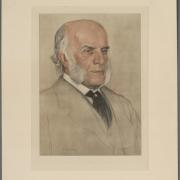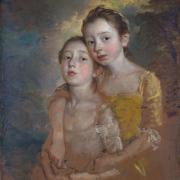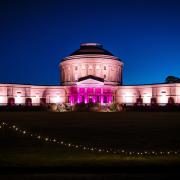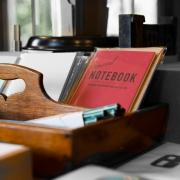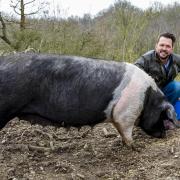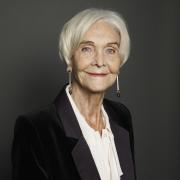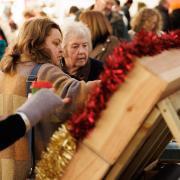Suffolk-based photographer John Ferguson has spent a good proportion of his life flying round the world taking photographs of everyone from Michael Jackson to war-torn communities.
His portfolio includes evocative portraits of the great and the good for high profile interviews in newspapers and magazines, sharp-looking commercial work to promote businesses, and sympathetic pictures of the unnamed and the forgotten for charities.
Personal projects include Black Britannia, an exhibition in London celebrating the contribution that black people have made to British culture over the past century, which drew the attention of then prime minister Gordon Brown.
But it's a project closer to home that's left him stunned and delighted. Ipswich Borough Council has just purchased a collection of 20 of John's pictures, and is showing a major retrospective of his work at The Wolsey Gallery, inside Christchurch Mansion, called A Eye for Life.

The portrait collection explores the concept of home for a diverse array of people from the African-Caribbean community, who were either born here or have made Suffolk their home.
'I've been completely blown away by it all. I don’t think it's sunk in – even now,' he says, as he comes to terms with the fact the borough has bought some of his work for the town’s permanent collection, and has honoured him with an exhibition.
Photography has always been a passion since John discovered he had an eye for capturing moments in time; a slice of life that told a story or a look on someone’s face that said something about the person in the photograph. His pictures are more than an image; they have a personality, a life.
'I’m a storyteller,' he says, 'that’s what it’s always been about for me. Whether it’s trying to capture the personality of David Bowie, to illustrate an interview, or trying to convey the life of a blind person, it’s always about telling a personal story.' He was introduced to photography by a teacher when he was 14.
'In class I saw a picture of Muhammed Ali in a fight, a really graphic picture, in a bout against Sonny Liston. It was part of a module on civil rights in America.

'The image and the story captivated me and I just wanted to know more, so I started exploring the backstory to the image and to the whole situation. The more I learned about the story, the more the picture came to life.'
John did a photography class at his north London school and was planning to go to university when fate stepped in to give his aspiring career some practical help.
'I spotted an ad for a press agency. They were looking for trainee photographers. I popped in and they said go upstairs and see the boss. We had a chat and he said you can have it now if you want it. I was stunned – I wasn’t expecting that.
'So I started working for a press agency in '85, then moved into working for newspapers. Piers Morgan saw me and offered me a job working at The Daily Mirror as their showbiz/entertainment photographer. I did that for 17 years.
'I feel really lucky because I've been flown all around the world to do jobs.' Nor was working on showbiz for a tabloid about snatching pictures on the street. While John covered a lot of award shows – the Oscars, BAFTA and the Golden Globes – he most of his work was portraits to accompany interviews.

'I had the opportunity to be creative I didn’t have what you would call free reign,' he says. 'Often you didn’t have that long with the person. They would have their team, their minders, who all had an opinion on what you were doing, and the subject sometimes wouldn’t be as co-operative and you would like.'
No matter that he may have flown from London to LA to find he had just 15 minutes to get a dazzling photograph. Thinking on his feet was an invaluable ability, as was the ability to communicate with his subjects and never being over-awed by them.
The one exception was David Bowie, with good reason as it turned out.
'Perhaps it was a warning,' he says, 'because it was on that shoot, all my equipment failed.' It was, he recalls, the perfect storm; the shoot that started badly because Bowie refused to do what John wanted him to do, and just got worse.
'I wanted him to sit on the corner of the bed, illuminated by a shaft of sunlight coming into the room. He just said: "No, I don’t think I want to do that".

'With that, his whole team fell silent and started looking at me as if there was trouble brewing. His manager came quietly over and just whispered in my ear: "John, you’ve got four minutes left." I hadn’t taken a single picture at this point. So, I went to get something on film and my camera died. It just died on me.'
Realising it was a difficult shoot and John was struggling with malfunctioning equipment, Bowie gave him a little extra time and, thankfully, he got a great shot. Six months later, there was a bizarre postscript to the occasion.
'Out of the blue I get an invitation from Bowie to go to Paris, to go to his concert and hang out with him backstage afterwards.
'There’s a saying, 'never meet your heroes', and I think that’s true to an extent. There are some lovely people, but there are others who seem to delight in making your life as difficult as possible.'
As time went on, John began to feel his work was becoming superficial. While at the Daily Mirror, with the paper's permission, he started doing freelance work for charities, telling different stories and recharging his batteries for the celebrity shoots.
'I wanted to use my photography skills to raise awareness of the plight of people battling to stay alive in the face of war, famine or deadly illnesses.. He spent a couple of weeks in New Orleans covering the aftermath of Hurricane Katrina.
'I really believe that good photography can tell important stories and open up conversations with people around the world,' he says.
John was conscious that his Suffolk-born wife, Julie, had to carry the burden of his absences, so when she said she wanted to be closer to her family and have some support raising their children, he agreed.
They moved to Ipswich, where Julie was born, almost overnight. 'I don’t think I even told the office – I was still with The Mirror – she sorted out the schools, everything, which proved to me how much she wanted to move.

'For me, being a London boy, it was a massive culture shock but, as an outsider, I can see how much the town has developed and grown, in the last 10 years, in particular.'
John continues to travel, but he has also worked hard to base his work much more in East Anglia. His personal projects often feature Suffolk or East Anglian subjects, focusing on storytelling and involving subjects that intrigue him.
'I get to tell people what’s going on in South Sudan, in Rwanda, in Kenya…I take the view that if I don’t know much about a place or a situation then I don’t suppose many others do either, and those are the projects I tend to pursue.'
Black Britannia was his break-out solo project, started while he was still working for the Daily Mirror.
'It was very much the era of 'Cool Britannia' and I felt it was important that black faces were also present highlighting their achievements. It was something that started in a modest way but just grew and grew.' The 50-portrait collection is now part of the National Portrait Gallery archive.

These personal projects have become increasingly important to John since he was made redundant from The Mirror 12 years ago. His day to day work now is focused on providing branding for people, charities and commercial companies. He is also a huge supporter of the local music scene, but it is his personal work that provides him with a real sense of purpose.
He has a number of projects on the go at any one time. At the moment he is chronicling the experience of blind people in a visual world, women in business, what life is like for an albino person, and what it is like to suffer from insomnia, a subject close to his heart.
'When I was made redundant from The Mirror I suffered with months of insomnia because I was really anxious about taking care of my family. I didn’t know what I was going to do. Would I make it in the freelance world after having been employed for so long?
'It was all going around in my brain and I just couldn’t sleep. Then I realised it wasn’t just me, so I created a project about the condition.'
John Ferguson’s photography retrospective An Eye For Life opens at The Wolsey Gallery, Christchurch Mansion, Ipswich on June 29, and runs until April 27, 2025.








